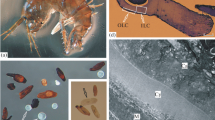Abstract
The tegument ofLigula intestinalis plerocercoids is delimited by a membrane complex that in electron microscopy appears heptalaminate. We suggest that the plerocercoids are covered by two closely apposed lipid bilayers. Double membranes, which are well known in schistosomes, are thus not a unique feature of blood parasitic Digenea but could be documented for the first time in a cestode species that lives in the peritoneal cavity of its host. The surface-membrane complex of plerocercoids was lost for the most part after conventional preparation for electron microscopy but could be completely retained by improved fixation using osmium tetroxide plus potassium ferrocyanide. Furthermore, one type of vesicle in the tegumental syncytium of plerocercoids has been found to be enclosed by at least two membranes, which might indicate that these vesicles contribute to the renewal of the surface-membrane complex. AdultLigula intestinalis removed from the gut of the final hostAnas platyrhnychos or obtained by in vitro transformation exhibited a single surface membrane and lacked double membrane vesicles. The elongate electron-dense caps of the microtriches of plerocercoids were replaced by short caps in the course of worm maturation. Thus, the tegumental surface of this parasite is fundamentally altered following the change in its environment from the peritoneal cavity of the intermediate host to the intestine of the final host.
Similar content being viewed by others
References
Behrman EJ (1983) The chemistry of osmium tetroxide fixation. In: Revel JP, Barnard T, Haggis GH (eds) The science of biological specimen preparation for microscopy and microanalysis. Scanning Electron Microscopy Inc., AMF O'Hare, pp 1–5
Charles GH, Orr TSC (1968) Comparative fine structure of outer tegument ofLigula intestinalis andSchistocephalus solidus. Exp Parasitol 22:137–149
Conradt U, Peters W (1989) Investigations on the occurrence of pinocytosis in the tegument ofSchistocephalus solidus. Parasitol Res 75:630–635
Dean LL, Podesta RB (1984) Electrophoretic patterns of protein synthesis and turnover in apical plasma membrane and outer bilayer ofSchistosoma mansoni. Biochim Biophys Acta 799:106–114
De Bruijn WC, Den Breejen P (1974) Selective glycogen contrast by hexavalent osmium oxide compounds. Histochem J 6:61–62
Dermer GB (1969) The fixation of pulmonary surfactant for electron microscopy. J Ultrastruct Res 27:88–104
Foley M, MacGregor AN, Kusel JR, Garland PB, Downie T, Moore I (1986) The lateral diffusion of lipid probes in the surface membrane ofSchistosoma mansoni. J Cell Biol 103:807–818
Hockley DJ, McLaren DJ (1973)Schistosoma mansoni: changes in the outer membrane of the tegument during development from cercaria to adult worm. Int J Parasitol 3:13–25
Holy JM, Oaks JA (1986) Ultrastructure of the tegumental microvilli (microtriches) ofHymenolepis diminuta. Cell Tissue Res 244:457–466
Hoole D, Arme C (1983) Ultrastructural studies on the cellular response of fish hosts following experimental infection with the plerocercoid ofLigula intestinalis (Cestoda: Pseudophyllidea). Parasitology 87:139–149
Hoole D, Arme C (1983) The role of serum in leucoyte adherence to the plerocercoid ofLigula intestinalis (cestoda: Pseudophyllidea). Parasitology 92:413–424
Iha RK, Smyth JD (1969)Echinococcus granulosus: ultrastructure of microtriches. Exp Parasitol 25:232–244
Karnovsky MJ (1971) Use of ferrocyanide-reduced osmium tetroxide in electron microscopy. Abstracts. Annual Meeting of the American Society of Cell Biology, New Orleans, p 146
McLaren DJ (1980)Schistosoma mansoni: the parasite surface in relation to host immunity. Research Studies Press, Chichester
McLaren DJ, Hockley DJ (1977) Blood flukes have a double outer membrane. Nature 269:147–149
Reynolds ES (1963) The use of lead citrate at high pH as an electron-opaque stain in electron microscopy. J Cell Biol 17:208–212
Richards KS, Arme C (1982) The microarchitecture of the structured bodies in the tegument ofCaryophyllaeus laticeps (Caryophyllidea: Cestoda). J Parasitol 63:425–432
Simpson AJG, Schryer MD, Cesari IM, Evans WH, Smithers SR (1981) Isolation and partial characterization of the tegumental outer membrane of adultSchistosoma mansoni. Parasitology 83:163–177
Threadgold LT, Hopkins CA (1981)Schistocephalus solidus andLigula intestinalis: pinocytosis by the tegument. Exp Parasitol 51:444–456
Weibull C, Christiansson A, Carlemalm E (1983) Extraction of membrane lipids during fixation, dehydration and embedding ofAcholeplasma laidlawii cells for electron microsocpy. J Microsc 129:201–207
White DL, Mazurkiewicz JE, Barrnett RJ (1979) A chemical mechanism for tissue staining by osmium tetroxide-ferrocyanide mixtures. J Histochem Cytochem 27:1084–1091
Williams MA, Hoole D (1990)Ligula intestinalis (Cestoda: Pseudophyllidae): studies on the antibody response of the intermediate hostRutilus rutilus. Abstracts, Annual Meeting of the International Congress of Parasitology, Paris, 20–24, 8 1990, p 1165
Author information
Authors and Affiliations
Additional information
This study was supported by a grant from the Deutsche Forschungsgemeinschaft
Rights and permissions
About this article
Cite this article
Conradt, U., Schmidt, J. A double surface membrane in plerocercoids ofLigula intestinalis (Cestoda: Pseudophyllidea). Parasitol Res 78, 123–129 (1992). https://doi.org/10.1007/BF00931653
Accepted:
Issue Date:
DOI: https://doi.org/10.1007/BF00931653




